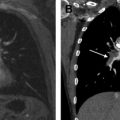PET/MR imaging, a new hybrid modality, is thought to have great potential in oncologic imaging because it provides advantages of both PET, which allows functional imaging capability, and MR imaging, which allows high spatial resolution imaging without radiation exposure. Despite the inherent weakness of MR imaging in lung imaging, initial studies on lung cancer revealed that PET/MR imaging showed highly correlated standardized uptake values of lesions and equivalent performance in terms of lesion detection and staging compared with PET/computed tomography (CT). Thus, to affirm the actual clinical benefits of dedicated PET/MR imaging over PET/CT, prospective studies with more patients are warranted.
Key points
- •
Integrated PET/MR imaging systems for the evaluation of lung cancer may be feasible owing to the development of new hardware systems with MR attenuation correction.
- •
PET/MR imaging showed highly correlated standardized uptake values of lesions and equivalent performance in terms of lesion detection and staging when compared with PET/CT according to several initial studies on this new hybrid modality.
- •
The synergistic benefits of integrated PET/MR imaging beyond simply adding the capabilities of the 2 modalities need to be validated with dedicated, time-efficient PET/MR imaging protocols.
Stay updated, free articles. Join our Telegram channel

Full access? Get Clinical Tree




